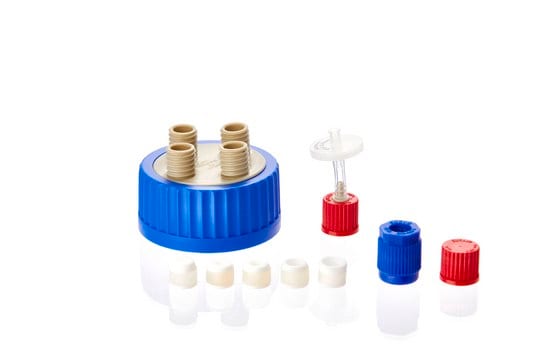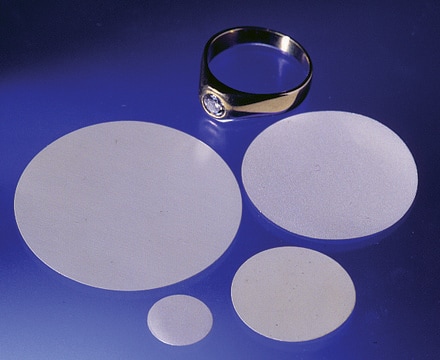WHA70604712
Whatman® polycarbonate Cyclopore® filter discs 3 μm pore size
translucent, hydrophobic, 100 ea, 47 mm diam
Synonyme(s) :
Z745790, filtration membranes, polycarbonate filters, polycarbonate membrane filters
About This Item
Produits recommandés
product name
Whatman® Cyclopore® polycarbonate and polyester membranes, cyclopore PC circles, 3.0 μm, 47 mm, 100/pk.
Matériaux
PC membrane
Stérilité
non-sterile
Conditionnement
pack of 100
Fabricant/nom de marque
Whatman 7060-4712
Whatman Article No. 28420654 (US reference)
Diamètre
47 mm
Dimension de pores
3 μm
Vous recherchez des produits similaires ? Visite Guide de comparaison des produits
Description générale
Whatman Cyclopore membranes are true pore size microporous membranes featuring sharp cut-off and reproducible microfiltration performance characteristics of track etched membranes. The smooth flat membrane ensures particles are retained on the surface so that they are easily visible under a microscope.
Cyclopore membranes are manufactured using proprietary Whatman technology to produce a precision membrane filter with a closely controlled pore size distribution.
Membranes are produced from a pure polymeric film and give exceptional chemical cleanliness. They are free of contaminants, have low tare weight, minimum water adsorption, and very low levels of nonspecific protein binding.
The polycarbonate (PC) membranes are hydrophilic and are available in a choice of diameters and pore sizes. The polyester (PE) membranes are resistant to most organic solvents, amides, and halogenated hydrocarbons. This broad chemical compatibility makes them suitable for the detection of particles in many corrosive fluids.
Application
- Air monitoring - Trace elements (chemicals, radioactivity) and particulate analysis (dust, pollens, and airborne particles)
- Analytical methods - Gravimetric analysis, densitometry, emission spectroscopy, x-ray fluorescence, and infrared analysis
- Water analysis - Absorbable organic halides (AOX), direct count of microorganisms, marine biology and dissolved phosphates, nitrates, and ammonia analysis
- Blood filtration and cell analysis - RBC deformability, leukocyte removal, RBC filtration and plasmapheresis, chemotaxis, cytology, and cell culture
- General filtration - Particulate and bacteria removal, cross flow filtration, HPLC sample preparation, and solution filtration
- Microscopy - Electron microscopy, epifluorescence microscopy, and direct optical microscopy
- Microorganism analysis - Direct total microbial count, harvesting, concentration, fractionation, yeast, molds, Giardia, Legionella, coliform, and canine microfilaria
- Nucleic acid studies - Alkaline elution and DNA fragment fractionation
- Oceanographic studies - provide a new tool for studying planktonic organisms. These ultra thin transparent membranes are strong yet flexible, allowing for planktonic samples to be filtered and the membranes to be mounted directly onto microscope slides. (Ref: Hewes et al. 1998; Graham and Mitchell 1999; Graham 1999.)
- Biosensors - as a barrier offering controlled diffusion for biological reagents and electrochemical detectors
- Diagnostic assays - for flow control, sample preparation, blood separation, and capture of latex microparticles
- Cell biology - for cell culture, chemotaxis, and cytological analyses, e.g., direct staining, isotopic and fluorescence based assays
- Transdermal drug delivery - as an inert matrix for retention of therapeutics
Caractéristiques et avantages
- Low affinity for stains providing higher optical contrast and making visibility under a microscope easy
- True surface capture provides easy examination of samples and short analysis times
- Totally transparent membranes available
- Negligible absorption and adsorption of filtrate; nonhygroscopic
- Low tare weights
- No particle shedding provides ultra clean filtrate
- Biologically inert
Informations légales
Certificats d'analyse (COA)
Recherchez un Certificats d'analyse (COA) en saisissant le numéro de lot du produit. Les numéros de lot figurent sur l'étiquette du produit après les mots "Lot" ou "Batch".
Déjà en possession de ce produit ?
Retrouvez la documentation relative aux produits que vous avez récemment achetés dans la Bibliothèque de documents.
Notre équipe de scientifiques dispose d'une expérience dans tous les secteurs de la recherche, notamment en sciences de la vie, science des matériaux, synthèse chimique, chromatographie, analyse et dans de nombreux autres domaines..
Contacter notre Service technique





